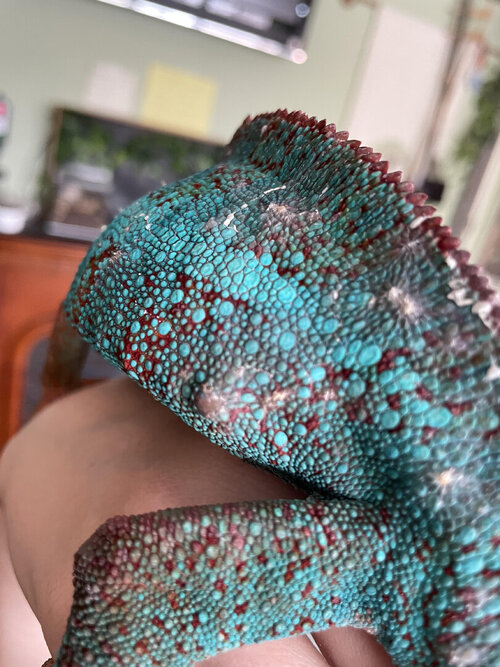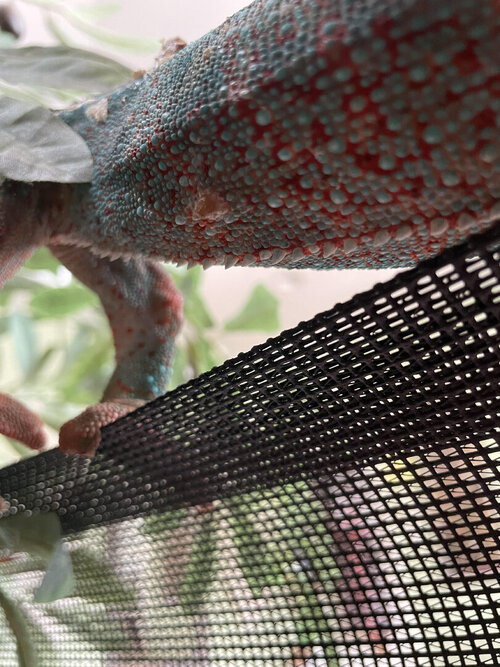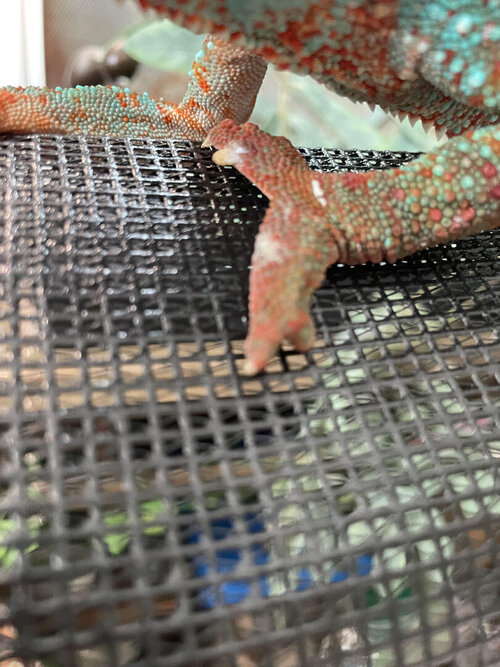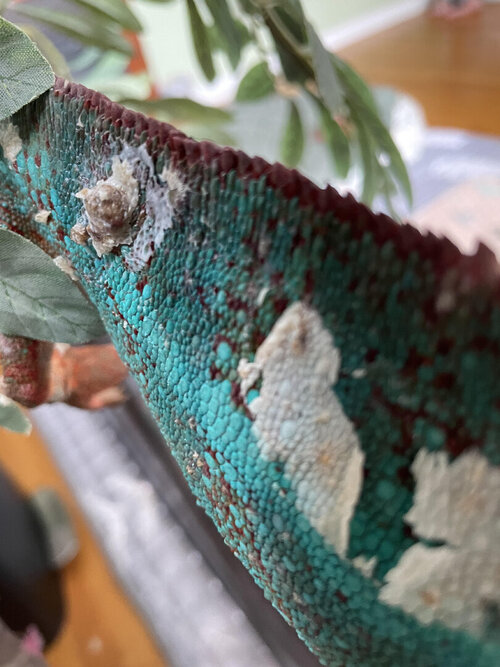BugzNelson
Member
Chameleon Info:
I've had Yato for 3 years. After he was just a little older than a year, I noticed a strange discoloring on his front left hand. In the following weeks, a few spots on his side appeared so I scheduled a visit with our local exotic vet. She examined him, said it may be bug bites (because I was releasing live crickets at this time), so I stopped with the live feed, started to only hand feed him and treated the spots with Chlorhexidine and Silver Sufadiazine cream. About 10 months later I returned to the vet because not only had the spots not gone away, they appeared worse and there was some type of growth on him. I didn't want to mess around anymore, so the vet took a stool sample, a blood sample, and scraped off some of the growth to send to a lab. Over a grand and a few weeks later, the lab came back saying it's not a known fungus, blood did not run positive for a variety of problems and basically we still have no idea what it is. I continue to treat the spots with the Chlorhexidine and Silver Sufadiazine since the vet said it's anti-bacterial and anti-fungal. But poor Yato's skin continues to look worse and the growths are now quite big and often get stuck shed on them. He's been dealing with this for 2 years now.
Note, Yato doesn't seem otherwise ill. I know the spots and growth are painful because he sensitive when I apple the topical treatment. However, Yato sill has energy, he does laps around his enclosure, his eyes are not sunken in, he's got a good appetite and decent strength. I know chameleons hide illness well, but these things still give me hope that this might not be fatal.
Has anyone dealt with this before, or have any information on it. How much of a threat is it to him?
- Your Chameleon - Yato is a Male Panther Chameleon, 3 years old. I've had him most of his life.
- Handling - Weekly to apply skin treatment.
- Feeding-
- Normally: Dubias, Black Soldier Flies and Hornworms. Occasionally a super worm or a silk worm. All tong or hand fed.
- Gutload:
- Repashy superload and Repashy bug burger.
- Supplements - RepCal Calcium no Phosphorus no vitamin D3, dusted daily. Repashy Cal Plus (with D3) dusted twice a month.
- Watering - I have a Mistking setup on an automatic timer, twice a day a for 2-3 minutes, early morning and late night. Also, a little dripper when needed.
- Fecal Description - While he doesn't poop as often as he used to, it always looks healthy
- Cage Type - 2ft x 2ft x 4ft. Mix of PVC, screen mesh at the top and bottom, and a plexi-glass door.
- Lighting - Arcadia 6% UVB T5 HO; Zoo Med 100W basking bulb on a dimmer, though I've not needed it recently. Sansi LED 70W Grow Light.
- Temperature- I read the top temp with an inkbird thermometer and the bottom temp with a Govee Thermometer/hydrometer
- Top/Basking:
- Week Average (Day and Night) Temp: 75.5 F
- Max (Day) Temp: 91.3 F
- Min (Night) Temp: 57.3 F (bought a heating pad to stop it from dropping this low at night again, though it does stay in the low 60s).
- Week Average (Day and Night) Temp: 75.5 F
- Bottom:
- Week Average (Day and Night) Temp: 64.7 F
- Max (Day) Temp: 71.6 F
- Min (Night) Temp: 56.7 F
- Week Average (Day and Night) Temp: 64.7 F
- Top/Basking:
- Humidity
- Average: 68.4%
- Max (Night): 91.8%
- Min (Day): 53.6%
- Average: 68.4%
- Plants - Pathos x3, common/poet's jasmine, a few fake plants for added foliage.
- Placement - It's a low traffic room without a fan and the vent is closed. Window occasionally open though. The top of the cage stands roughly 6.5ft from the floor (4ft cage+~2.5ft table).
- Location - California, valley not coastal.
I've had Yato for 3 years. After he was just a little older than a year, I noticed a strange discoloring on his front left hand. In the following weeks, a few spots on his side appeared so I scheduled a visit with our local exotic vet. She examined him, said it may be bug bites (because I was releasing live crickets at this time), so I stopped with the live feed, started to only hand feed him and treated the spots with Chlorhexidine and Silver Sufadiazine cream. About 10 months later I returned to the vet because not only had the spots not gone away, they appeared worse and there was some type of growth on him. I didn't want to mess around anymore, so the vet took a stool sample, a blood sample, and scraped off some of the growth to send to a lab. Over a grand and a few weeks later, the lab came back saying it's not a known fungus, blood did not run positive for a variety of problems and basically we still have no idea what it is. I continue to treat the spots with the Chlorhexidine and Silver Sufadiazine since the vet said it's anti-bacterial and anti-fungal. But poor Yato's skin continues to look worse and the growths are now quite big and often get stuck shed on them. He's been dealing with this for 2 years now.
Note, Yato doesn't seem otherwise ill. I know the spots and growth are painful because he sensitive when I apple the topical treatment. However, Yato sill has energy, he does laps around his enclosure, his eyes are not sunken in, he's got a good appetite and decent strength. I know chameleons hide illness well, but these things still give me hope that this might not be fatal.
Has anyone dealt with this before, or have any information on it. How much of a threat is it to him?
Attachments
Last edited:










